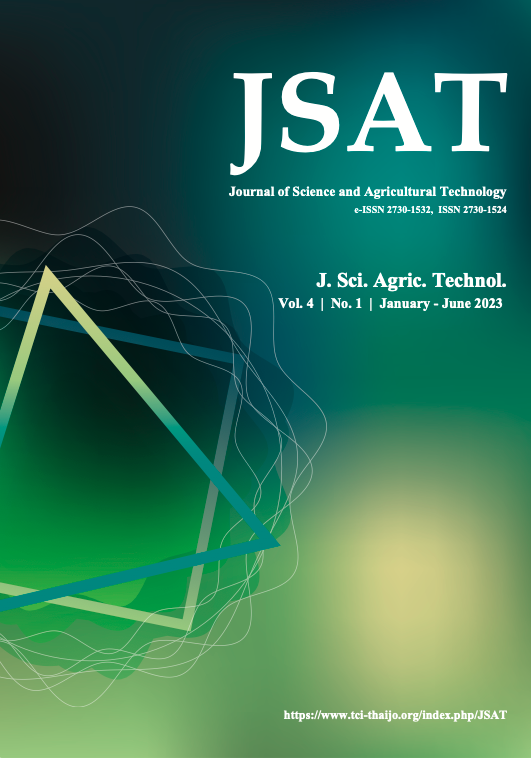Spray-dried powder of Bacillus amyloliquefaciens strain C2-1 for control of rice diseases
Main Article Content
Abstract
Rice cultivation in Thailand faces challenges in achieving high yields due to diseases. This research aims to develop a spray-dried powder containing Bacillus amyloliquefaciens strain C2-1 for control economically damaging rice diseases caused by Xanthomonas oryzae, Fusarium moniliforme, Pyricularia grisea, and Bipolaris oryzae. The B. amyloliquefaciens strain C2-1 was cultured in 3 different media, including 1) medium contained nutrient broth with glucose (NB), 2) medium contained beef extract, molasses, K2HPO4 and KH2PO4 (BM), and 3) medium contained yeast extract, molasses, K2HPO4, and KH2PO4 (YM). The results showed that YM medium gave the highest concentration of bacteria at 1.30x1016cfu/ml, followed by BM medium at 9.88x1012 cfu/ml, and NB medium at 5.3x1012cfu/ml. Therefore, YM medium was selected as the optimal culture medium. Subsequently, the B. amyloliquefaciens strain C2-1 was produced into a spray-dried powder using the spray-drying technique. Tapioca starch and carboxymethyl cellulose were used as spray-drying carriers in a ratio of 10:1. The optimal spray-drying conditions included a hot air inlet temperature of 90°C, a hot air outlet temperature of 70°C, and a feed rate of 10-15 ml/min, resulting in the highest survival rate at 2.8×1012 CFU/g-1. The efficacy of B. amyloliquefacien strain C2-1 powder was then tested against rice diseases. The inhibition of X. oryzae was assessed using the paper disc diffusion method, while the inhibitions of F. moniliforme, P. grisae, and B. oryzea were evaluated using dual culture assay. The results demonstrated that B.amyloliquefacien strain C2-1) powder exhibited strong inhibitory effects against X. oryzae, with clear zone measuring 5.5, 5.7, and 5.7 mm at 24, 48, and 72 h, respectively. Regarding inhibiting F. moniliforme, P. grisae, and B. oryzea, B. amyloliquefaciens strain C2-1 demonstrated effective control of these rice pathogenic fungi, resulting in inhibitions of 73.0%, 68.72%, and 48.42% at 7 days, respectively. These findings strongly suggest that the B.amyloliquefacien strain C2-1 obtained from spray drying serves as a promising biocontrol agent against bacterial leaf blight disease, bacterial blight, bakanae disease, rice blast disease, and brown spot disease caused by F. moniliforme, P. grisae, and B. oryzea, respectively.
Article Details

This work is licensed under a Creative Commons Attribution-NonCommercial-NoDerivatives 4.0 International License.
References
Chintaganom, T., Watcharachaiyakup, J., Wonnapinji, P., Tongyoo and Patarapuwadol, S. 2022. Draft genome sequence and population structure of Xanthomonas oryzae pv. oryzae causing bacterial blight disease on rice in Thailand. Thai Agriculture Research Journal. 40(1). https://doi.org/10.14456/thaidoa-agres.2022.4
Chumthong, A. wiwattanapatapee, R. viernstein, H. pengnoo, A. and kanjanamaneesathian, M. 2016. Spray-dried powder of Bacillus megaterium for control of rice sheath blight disease: Formulation protocol and efficacy testing in laboratory and greenhouse. Cereal Research Communications. 44(1): 131–140. https://doi.org/10.1556/0806.43.2015.034.
Desmond, C., Stanton, C., Fitzgerald, F.G., Collins, K., Ross, P.R. 2001. Environmental adaptation of probiotic lactobacilli towards improvement of performance during spray drying. International Dairy Journal. 11(10): 801-808. https://doi.org/10.1016/S0958-6946(01)00121-2.
Daniel, V.M., Vicente, E.S., César, L.P, Patricia, A.B., Fidel, M.G., Manuel, R.A. and María, Z.S.L. 2020. Preparation of spray-dried functional food: Effect of adding Bacillus clausii bacteria as a co-microencapsulating agent on the conservation of Resveratrol. Processes. 8(7): 849. https://doi.org/10.3390/pr8070849.
Dorneles, R.K., Refatti, P.J., Pazdiora, C.P., Avila, A.L., Deuner, S. and Dallagnol, J.L. 2020. Biochemical defenses of rice against Bipolaris oryzae increase with high atmospheric concentration of CO2. Physiological and Molecular Plant Pathology. 110: 101484 https://doi.org/10.1016/j.pmpp. 2020.101484.
Ezuka, A. and Kaku, H. 2000. A historical review of bacterial blight of rice. Bulletin of the National Institute of Agrobiological Resource. 15:1-207.
León-Martínez, F.M., Méndez-Lagunas, L.L., Rodríguez-Ramírez, J. 2010. Spray drying of nopal mucilage (Opuntia ficus-indica): Effects on powder properties and characterization. Carbohydrate Polymer. 81: 864-870. https://doi.org/10.1016/j.carbpol.2010.03.061.
Morton, D.J., and Stroube, W.H. 1955. Antagonistic and stimulatory effects of soil microorganisms upon Sclerotium rolfsii. Phytopathol. 45: 417-420.
Prabhukarthikeyan, S.R., Yadav, M.K., Anandan, A., Aravindan, S., Keerthana, U., Raghu, S., Baite, M.S., Parameswaran, C., Panneerselvam, P., and Rath, P.C. 2019. Bio-protection of brown spot disease of rice and insight into the molecular basis of interaction between Oryza sativa, Bipolaris oryzae and Bacillus amyloliquefaciens, Biological Control. 137: 104018. https://doi.org/10.1016/j.biocontrol.2019.104018.
Saleh, A.S., Imtiaz, A.A., Hossian Md.B., Husna, A., and khatun Eaty, Most.N. 2020. Review: Rice blast disease. Annual Research & Review in Biology. 35(1): 50-64 https://doi.org/10.9734/ARRB/2020/v35i130180.
Shrestha, B.K., Karki, H.S., Groth, D.E., Jungkhun, N., and Ham, J.H. 2016. Biological control activities of rice-associated Bacillus sp. strains against sheath blight and bacterial panicle blight of rice. PLoS One. 11(1): e0146764. https://doi.org/10.1371/journal.pone.0146764.
Srivastava, S., Bist, V., Srivastava, S., Singh, P.C., Trivedi, P.K., Asif, M.H., Chauhan, P.S., and Nautiyal, C.S. 2016. Unraveling aspects of Bacillus amyloliquefaciens mediated enhanced production of rice under biotic stress of Rhizoctonia solani. Front. Plant Sci., 06 May 2016. https://doi.org/10.3389/fpls.2016.00587.
Teera-Arunsiri, A., Suphantharika, M., and Ketunuti, U. 2003. Preparation of spray-dried wettable powder formulations of Bacillus thuringiensis-based biopesticides. Journal of Economic Entomology. 96: 292–299. https://doi.org/10.1603/0022-0493-96.2.292.
Thano P., and Akarapisan A. 2018. Development of bio-product from Bacillus amyloliquefaciens for controlling bacterial wilt of curcuma (Curcuma lismatifolia). Agricultural Sci. J. 49: 1 (Suppl.): 650-652.
Wu, L., Wu, H., Chen, L., Yu, X.F., Borriss, R., and Gao, X. 2015. Difficidin and bacilysin from Bacillus amyloliquefaciens FZB42 have antibacterial activity against Xanthomonas oryzae rice pathogens. Sci. Rep.5:12975. https://doi.org/10.1038/srep12975.
Yang, E., Fan, L., Jiang, Y., Doucette, C., and Filmore S. 2012. Antimicrobial Activity of Bacteriocin-Producing Lactic Acid Bacteria Isolated from Cheeses and Yogurts. AMB express a Springer Open journal. 2(48).
Yánez, V., Vinas, I., Usall, J., and Torres, R. 2012. Formulation development of the biocontrol agent Bacillus subtilis strain CPA-8 by spray-drying. Journal of Applied Microbiology 112(5):954-65 https://doi.org/10.1111/j.1365-2672.2012. 05258.x.
Zuberer, D.A. 1994. Recovery and enumeration of viable bacteria. In: Weaver, R.W., Angle, S., Bottomley, P., Bezdicek, D., Smith, S., Tabatabai, A., Wollum, A. (eds). Methods of Soil Analysis: Part 2, Microbiological and Biochemical Properties, Number 5. Soil Science Society of America Book Series. Soil Science Soc. of America Inc. Wisconsin. p. 119–143.


